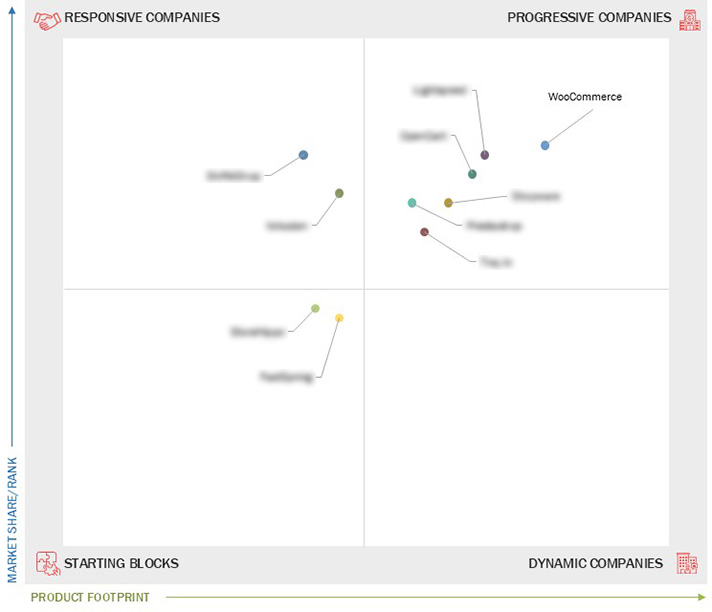Comparing 10 vendors in E-Commerce Platform Startups across 0 criteria.
The eCommerce platform market is evolving rapidly, driven by the growing demand for online shopping and mobile commerce. Businesses are increasingly adopting digital solutions to enhance customer experiences, streamline operations, and expand their reach. Platforms offer features like product management, payment processing, and mobile optimization. Both large retailers and small businesses are embracing eCommerce to stay competitive. B2B companies are also shifting toward digital interactions, aiming to match the seamless experiences offered by B2C platforms. This dynamic landscape presents opportunities for innovation and growth.
Market Leadership Quadrant
1.1 Study Objectives
1.2 Market Definition
1.3 Study Scope
1.3.1 Market Segmentation and Regional Scope
1.3.2 Inclusions & Exclusions
1.3.3 Years Considered
1.4 Currency Considered
1.5 Stakeholders
1.6 Summary of Changes
2.1 Market Overview
2.2 Market Dynamics
2.2.1 Drivers
2.2.1.1 Increasing Online Consumer Base with Growing Adoption of
Smartphones to Fuel Demand for Ecommerce Platforms
2.2.1.2 Omnichannel Retailing to Drive Demand for Ecommerce
Platforms
2.2.1.3 Increasing Internet Penetration Worldwide to Fuel Adoption
of Ecommerce Platforms
2.2.1.4 Rising Need to Enhance Global Presence to Increase Adoption
of Ecommerce Platforms
2.2.2 Restraints
2.2.2.1 Cybersecurity Issues and Online Scams to Hinder Market
Growth
2.2.3 Opportunities
2.2.3.1 Development of Super Apps to Offer More Simple and
Convenient Shopping Options
2.2.3.2 Rising Investments in Ecommerce Sector
2.2.3.3 Buy Now Pay Later (BNPL) to Support Growth of Ecommerce
Platform Market
2.2.4 Challenges
2.2.4.1 Handling Logistics and Managing Inventory to Pose
Substantial Challenges for Businesses
2.2.4.2 Customer Acquisition and Retention to be Expensive in
Competitive Era
2.3 Brief History of Ecommerce Platform
2.4 Ecosystem Analysis
2.5 Supply Chain Analysis
2.5.1 Platform Providers
2.5.2 Service Providers
2.5.3 System Integrators
2.5.4 Logistics Providers
2.5.5 Payment Gateway Providers
2.5.6 End Users
2.6 Patent Analysis
2.6.1 Methodology
2.6.2 Ecommerce Platform Market: Key Patents, 2016–2025
2.7 Trends and Disruptions Impacting Customer Business
2.8 Porter’s Five Forces Analysis
2.8.1 Threat of New Entrants
2.8.2 Threat of Substitutes
2.8.3 Bargaining Power of Buyers
2.8.4 Bargaining Power of Suppliers
2.8.5 Intensity of Competitive Rivalry
2.9 Key Conferences and Events, 2025–2026
2.10 Technology Analysis
2.10.1 Introduction
2.10.2 Key Technologies
2.10.2.1 Content Management Systems
2.10.2.2 Database Management Systems
2.10.2.3 Cloud Computing
2.10.3 Adjacent Technologies
2.10.3.1 Payment Gateways
2.10.3.2 Customer Relationship Management
2.10.3.3 Content Delivery Networks
2.10.4 Complementary Technologies
2.10.4.1 Augmented Reality
2.10.4.2 Headless Commerce Architecture
2.10.4.3 Warehouse Automation
2.11 Best Practices in Ecommerce Platform Market
2.12 Technology Roadmap for Ecommerce Platform Market
2.12.1 Ecommerce Platform Roadmap Till 2033
2.12.1.1 Short-term Roadmap (2025-2027)
2.12.1.2 Mid-term Roadmap (2028-2030)
2.12.1.3 Long-term Roadmap (2031-2033)
2.13 Impact of AI/generative AI on Ecommerce Platform Market
2.13.1 Use Cases of Generative AI in Ecommerce Platform
2.14 Investment and Funding Scenario (2024)
2.15 Impact of US Tariff–ecommerce Platform Market
2.15.1 Introduction
2.15.2 Key Tariff Rates
2.15.3 Price Impact Analysis
2.15.3.1 Strategic Shifts and Emerging Trends
2.15.4 Impact on Country/Region
2.15.4.1 US
2.15.4.2 China
2.15.4.3 Europe
2.15.4.4 Asia Pacific (Excluding China)
2.15.5 Impact on End-use Industry
2.15.5.1 Beauty & Personal Care
2.15.5.2 Consumer Electronics
2.15.5.3 Fashion & Apparel
2.15.5.4 Food & Beverage
2.15.5.5 Home Décor
2.15.5.6 Health & Wellness
2.15.5.7 Household Consumables
2.15.5.8 Other Industries
3.1 Overview
3.2 Strategies Adopted By Key Players
3.3 Revenue Analysis, 2020–2024
3.4 Market Share Analysis of Top Players, 2024
3.5 Company Valuation and Financial Metrics
3.6 Brand/product Comparison
3.7 Company Evaluation Matrix: Startups/SMEs, 2025
3.7.1 Progressive Companies
3.7.2 Responsive Companies
3.7.3 Dynamic Companies
3.7.4 Starting Blocks
3.7.5 Competitive Benchmarking: Startups/SMEs, 2025
3.7.5.1 Detailed List of Key Startups/SMEs
3.7.5.2 Competitive Benchmarking of Key Startups/SMEs
3.8 Competitive Scenario
3.8.1 Product Launches
3.8.2 Deals
4.1 FastSpring
4.1.1 Business overview
4.1.2 Products/Solutions/Services offered
4.1.3 Recent developments
4.2 LIGHTSPEED
4.2.1 Business overview
4.2.2 Products/Solutions/Services offered
4.2.3 Recent developments
4.3 OpenCart
4.3.1 Business overview
4.3.2 Products/Solutions/Services offered
4.3.3 Recent developments
4.4 PrestaShop
4.4.1 Business overview
4.4.2 Products/Solutions/Services offered
4.4.3 Recent developments
4.5 SHOPWARE
4.5.1 Business overview
4.5.2 Products/Solutions/Services offered
4.5.3 Recent developments
4.6 Shift4Shop
4.6.1 Business overview
4.6.2 Products/Solutions/Services offered
4.6.3 Recent developments
4.7 StoreHippo
4.7.1 Business overview
4.7.2 Products/Solutions/Services offered
4.7.3 Recent developments
4.8 Tray
4.8.1 Business overview
4.8.2 Products/Solutions/Services offered
4.8.3 Recent developments
4.9 VOLUSION
4.9.1 Business overview
4.9.2 Products/Solutions/Services offered
4.9.3 Recent developments
4.10 WooCommerce
4.10.1 Business overview
4.10.2 Products/Solutions/Services offered
4.10.3 Recent developments


 FastSpring
FastSpring
 Apr 2025
Apr 2025

